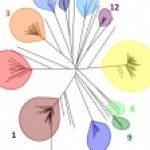Lien vers Pubmed [PMID] – 16672411
J. Clin. Microbiol. 2006 May;44(5):1810-20
Candida albicans is a human commensal that is also responsible for superficial and systemic infections. Little is known about the carriage of C. albicans in the digestive tract and the genome dynamics that occur during commensalisms of this diploid species. The aim of this study was to evaluate the prevalence, diversity, and genetic relationships among C. albicans isolates recovered during natural colonization of the digestive tract of humans, with emphasis on Crohn’s disease patients who produce anti-yeast antibodies and may have altered Candida sp. carriage. Candida sp. isolates were recovered from 234 subjects within 25 families with multiple cases of Crohn’s disease and 10 control families, sampled at the oral and fecal sites. Prevalences of Candida sp. and C. albicans carriage were 53.4% and 46.5%, respectively, indicating frequent commensal carriage. No differences in prevalence of carriage could be observed between Crohn’s disease patients and healthy subjects. Multilocus sequence typing (MLST) of C. albicans isolates revealed frequent colonization of a subject or several members of the same family by genetically indistinguishable or genetically close isolates. These latter isolates differed by loss-of-heterozygosity events at one or several of the MLST loci. These loss-of-heterozygosity events could be due to either chromosome loss followed by duplication or large mitotic recombination events between complementary chromosomes. This study was the first to jointly assess commensal carriage of C. albicans, intrafamilial transmission, and microevolution. The high frequency of each of these events suggests that the digestive tract provides an important and natural niche for microevolutions of diploid C. albicans through the loss of heterozygosity.





